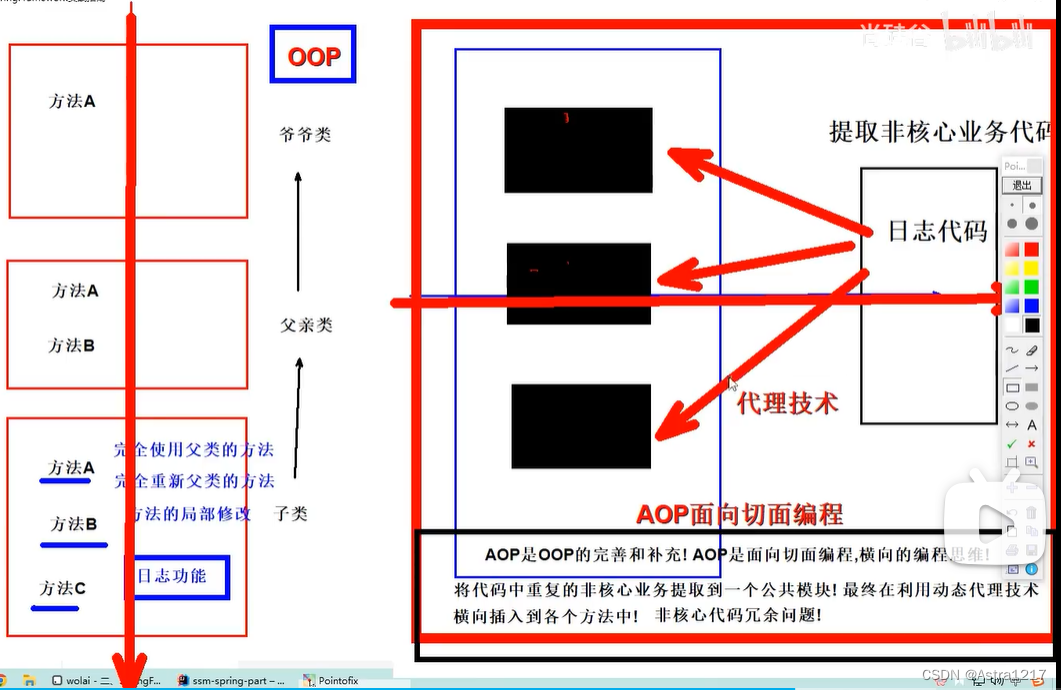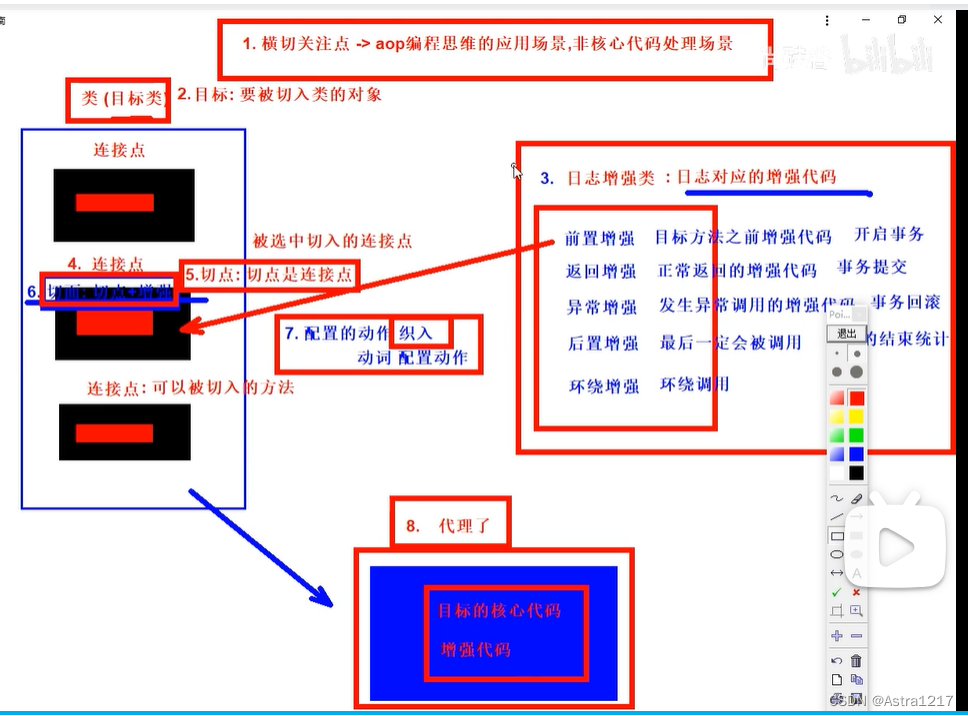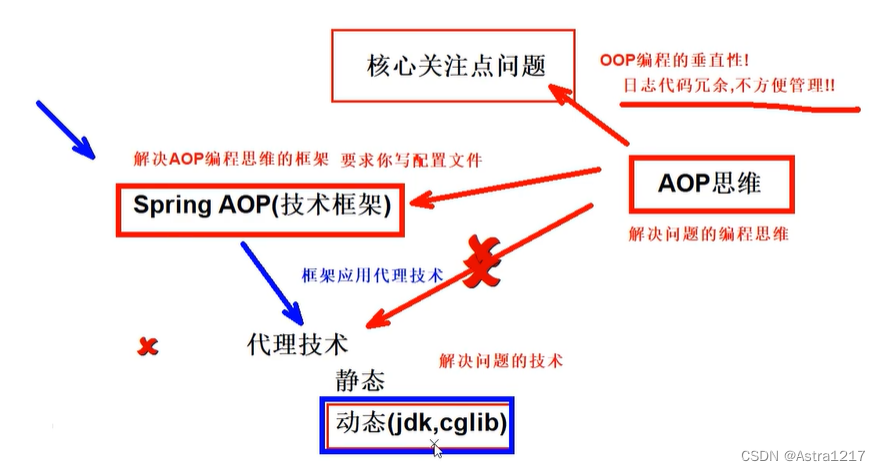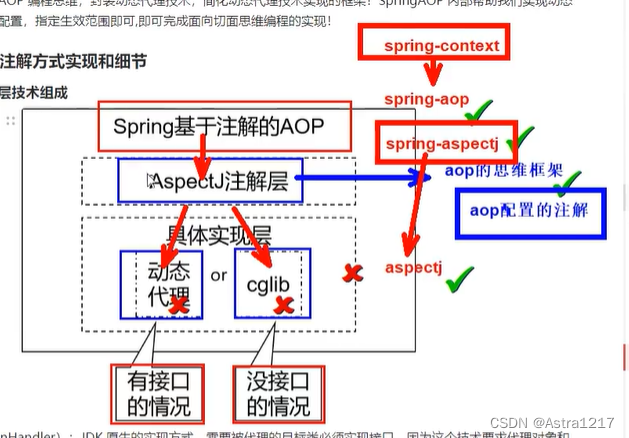文章目录
前言
AOP是什么?AOP框架是什么?
一、问题
问题分析
附加功能代码重复,分散在各个业务功能方法中!冗余,且不方便统一维护!
解决思路
解耦。 将重复的代码统一提取,并且动态插入到每个业务方法。
代理模式
通过提供一个代理类,让我们在调用目标方法的时候,不再是直接对目标方法进行调用,而是通过代理类间接调用。
二、AOP思维
1、AOP和OOP的区别

2、相关术语名词

三、Spring AOP框架
1、概念
基于AOP编程思维,封装动态代理技术,简化动态代理技术实现的框架!SpringAOP内部帮助我们实现动态代理,我们只需写少量的配置,指定生效范围即可完成面向切面思维编程的实现!

2、底层技术组成

JDK动态代理:JDK原生的实现方式,需要被代理的目标类必须实现接口
cglib:通过继承被代理的目标类实现代理,所以不需要目标类实现接口!
AspectJ:早期的AOP实现的框架,SpringAOP借用了AspectJ中的AOP注解。
3、实现步骤

(1)导入依赖pom.xml
<!-- spring-aspects会帮我们传递过来aspectjweaver -->
<dependency>
<groupId>org.springframework</groupId>
<artifactId>spring-aop</artifactId>
<version>6.0.6</version>
</dependency>
<dependency>
<groupId>org.springframework</groupId>
<artifactId>spring-aspects</artifactId>
<version>6.0.6</version>
</dependency>
(2)准备接口和实现类
public interface Calculator {
int add(int i, int j);
}
package com.atguigu.proxy;
//实现类
@Component
public class CalculatorPureImpl implements Calculator {
@Override
public int add(int i, int j) {
int result = i + j;
return result;
}
}
(3)声明切面类
@Aspect // @Aspect表示这个类是一个切面类
@Component // @Component注解保证这个切面类能够放入IOC容器
public class LogAspect {
// @Before注解:声明当前方法是前置通知方法
// value属性:指定切入点表达式,由切入点表达式控制当前通知方法要作用在哪一个目标方法上
@Before(value = "execution(public int com.atguigu.proxy.CalculatorPureImpl.add(int,int))")
public void printLogBeforeCore() {
System.out.println("[AOP前置通知] 方法开始了");
}
@AfterReturning(value = "execution(public int com.atguigu.proxy.CalculatorPureImpl.add(int,int))")
public void printLogAfterSuccess() {
System.out.println("[AOP返回通知] 方法成功返回了");
}
@AfterThrowing(value = "execution(public int com.atguigu.proxy.CalculatorPureImpl.add(int,int))")
public void printLogAfterException() {
System.out.println("[AOP异常通知] 方法抛异常了");
}
@After(value = "execution(public int com.atguigu.proxy.CalculatorPureImpl.add(int,int))")
public void printLogFinallyEnd() {
System.out.println("[AOP后置通知] 方法最终结束了");
}
}
(4)开启aspectj注解支持
@Configuration
@ComponentScan(basePackages = "com.atguigu")
//作用等于 <aop:aspectj-autoproxy /> xml配置类上开启 Aspectj注解支持!
@EnableAspectJAutoProxy
public class MyConfig {}
4、获取通知细节
(1)JoinPoint接口
需要获取方法签名、传入的实参等信息时,可以在通知方法声明JoinPoint类型的形参。
(2)方法返回值
通过@AfterReturning注解的returning属性获取目标方法的返回值!
(3)异常对象捕捉
在异常通知中,通过@AfterThrowing注解的throwing属性获取目标方法抛出的异常对象
// @AfterThrowing注解标记异常通知方法
@AfterThrowing(
value = "execution(public int com.atguigu.aop.api.Calculator.add(int,int))",
// 在返回通知中获取目标方法返回值分两步:
// 第一步:在@AfterReturning注解中通过returning属性设置一个名称
// 第二步:使用returning属性设置的名称在通知方法中声明一个对应的形参
returning = "targetMethodReturnValue",
// 在异常通知中获取目标方法抛出的异常分两步:
// 第一步:在@AfterThrowing注解中声明一个throwing属性设定形参名称
// 第二步:使用throwing属性指定的名称在通知方法声明形参,Spring会将目标方法抛出的异常对象从这里传给我们
throwing = "targetMethodException"
)
public void printLogAfterCoreException(JoinPoint joinPoint, Throwable targetMethodException) {
// 1.通过JoinPoint对象获取目标方法签名对象
// 方法的签名:一个方法的全部声明信息
Signature signature = joinPoint.getSignature();
// 2.通过方法的签名对象获取目标方法的详细信息
String methodName = signature.getName();
System.out.println("methodName = " + methodName);
int modifiers = signature.getModifiers();
System.out.println("modifiers = " + modifiers);
String declaringTypeName = signature.getDeclaringTypeName();
System.out.println("declaringTypeName = " + declaringTypeName);
// 3.通过JoinPoint对象获取外界调用目标方法时传入的实参列表
Object[] args = joinPoint.getArgs();
// 4.由于数组直接打印看不到具体数据,所以转换为List集合
List<Object> argList = Arrays.asList(args);
System.out.println("[AOP异常通知] "+methodName+"方法抛异常了,异常类型是:" + targetMethodException.getClass().getName());
}
5、重用切点表达式(@Pointcut)
// 切入点表达式重用
@Pointcut("execution(public int com.atguigu.aop.api.Calculator.add(int,int)))")
public void declarPointCut() {}
//同类引用
@Before(value = "declarPointCut()")
//不同类引用
@Before(value = "com.atguigu.spring.aop.aspect.LogAspect.declarPointCut()")
public void printLogBeforeCoreOperation(JoinPoint joinPoint) {}
6、环绕通知
环绕通知对应整个 try…catch…finally 结构
// 使用@Around注解标明环绕通知方法
@Around(value = "com.atguigu.aop.aspect.AtguiguPointCut.transactionPointCut()")
public Object manageTransaction(
// 通过在通知方法形参位置声明ProceedingJoinPoint类型的形参,
// Spring会将这个类型的对象传给我们
ProceedingJoinPoint joinPoint) {
// 通过ProceedingJoinPoint对象获取外界调用目标方法时传入的实参数组
Object[] args = joinPoint.getArgs();
// 通过ProceedingJoinPoint对象获取目标方法的签名对象
Signature signature = joinPoint.getSignature();
// 通过签名对象获取目标方法的方法名
String methodName = signature.getName();
// 声明变量用来存储目标方法的返回值
Object targetMethodReturnValue = null;
try {
// 在目标方法执行前:开启事务(模拟)
log.debug("[AOP 环绕通知] 开启事务,方法名:" + methodName + ",参数列表:" + Arrays.asList(args));
// 过ProceedingJoinPoint对象调用目标方法
// 目标方法的返回值一定要返回给外界调用者
targetMethodReturnValue = joinPoint.proceed(args);
// 在目标方法成功返回后:提交事务(模拟)
log.debug("[AOP 环绕通知] 提交事务,方法名:" + methodName + ",方法返回值:" + targetMethodReturnValue);
}catch (Throwable e){
// 在目标方法抛异常后:回滚事务(模拟)
log.debug("[AOP 环绕通知] 回滚事务,方法名:" + methodName + ",异常:" + e.getClass().getName());
}finally {
// 在目标方法最终结束后:释放数据库连接
log.debug("[AOP 环绕通知] 释放数据库连接,方法名:" + methodName);
}
return targetMethodReturnValue;
}
























 816
816

 被折叠的 条评论
为什么被折叠?
被折叠的 条评论
为什么被折叠?








